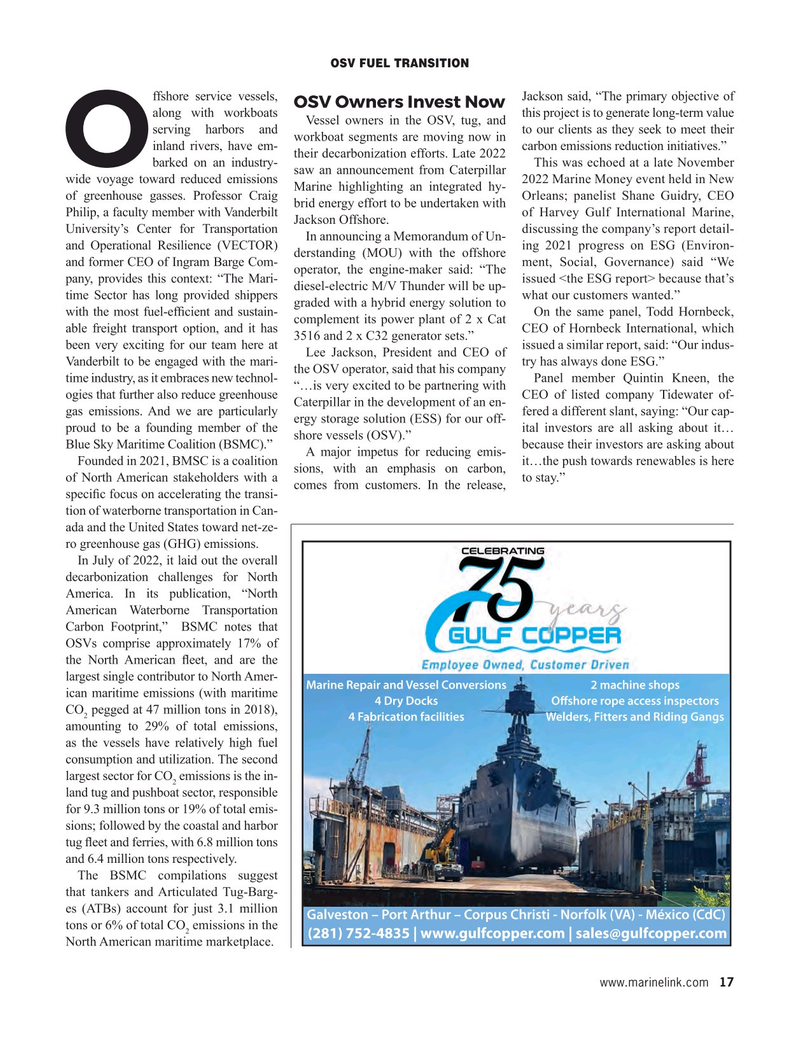
Page 17: of Maritime Reporter Magazine (April 2023)
Cruise Shipping
Read this page in Pdf, Flash or Html5 edition of April 2023 Maritime Reporter Magazine
OSV FUEL TRANSITION ffshore service vessels, Jackson said, “The primary objective of
OSV Owners Invest Now along with workboats this project is to generate long-term value
Vessel owners in the OSV, tug, and serving harbors and to our clients as they seek to meet their workboat segments are moving now in inland rivers, have em- carbon emissions reduction initiatives.” their decarbonization efforts. Late 2022
Obarked on an industry- This was echoed at a late November saw an announcement from Caterpillar wide voyage toward reduced emissions 2022 Marine Money event held in New
Marine highlighting an integrated hy- of greenhouse gasses. Professor Craig Orleans; panelist Shane Guidry, CEO brid energy effort to be undertaken with
Philip, a faculty member with Vanderbilt of Harvey Gulf International Marine,
Jackson Offshore.
University’s Center for Transportation discussing the company’s report detail-
In announcing a Memorandum of Un- and Operational Resilience (VECTOR) ing 2021 progress on ESG (Environ- derstanding (MOU) with the offshore and former CEO of Ingram Barge Com- ment, Social, Governance) said “We operator, the engine-maker said: “The pany, provides this context: “The Mari- issued
Lee Jackson, President and CEO of
Vanderbilt to be engaged with the mari- try has always done ESG.” the OSV operator, said that his company time industry, as it embraces new technol- Panel member Quintin Kneen, the “…is very excited to be partnering with ogies that further also reduce greenhouse CEO of listed company Tidewater of-
Caterpillar in the development of an en- gas emissions. And we are particularly fered a different slant, saying: “Our cap- ergy storage solution (ESS) for our off- proud to be a founding member of the ital investors are all asking about it… shore vessels (OSV).”
Blue Sky Maritime Coalition (BSMC).” because their investors are asking about
A major impetus for reducing emis-
Founded in 2021, BMSC is a coalition it…the push towards renewables is here sions, with an emphasis on carbon, of North American stakeholders with a to stay.” comes from customers. In the release, speci? c focus on accelerating the transi- tion of waterborne transportation in Can- ada and the United States toward net-ze- ro greenhouse gas (GHG) emissions.
In July of 2022, it laid out the overall decarbonization challenges for North
America. In its publication, “North
American Waterborne Transportation
Carbon Footprint,” BSMC notes that
OSVs comprise approximately 17% of the North American ? eet, and are the largest single contributor to North Amer-
Marine Repair and Vessel Conversions 2 machine shops ican maritime emissions (with maritime 4 Dry Docks O! shore rope access inspectors
CO pegged at 47 million tons in 2018), 2 4 Fabrication facilities Welders, Fitters and Riding Gangs amounting to 29% of total emissions, as the vessels have relatively high fuel consumption and utilization. The second largest sector for CO emissions is the in- 2 land tug and pushboat sector, responsible for 9.3 million tons or 19% of total emis- sions; followed by the coastal and harbor tug ? eet and ferries, with 6.8 million tons and 6.4 million tons respectively.
The BSMC compilations suggest that tankers and Articulated Tug-Barg- es (ATBs) account for just 3.1 million
Galveston – Port Arthur – Corpus Christi - Norfolk (VA) - México (CdC) tons or 6% of total CO emissions in the 2 (281) 752-4835 | www.gulfcopper.com | [email protected]
North American maritime marketplace.
www.marinelink.com 17
MR #4 (1-17).indd 17 4/6/2023 11:02:26 AM

 16
16

 18
18
